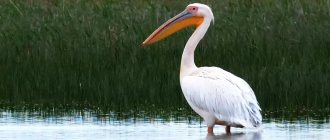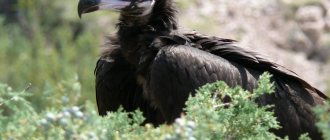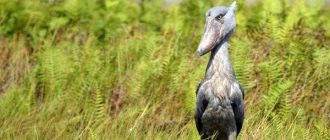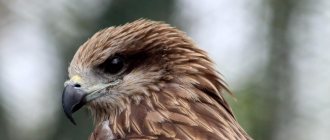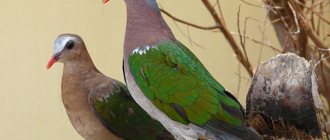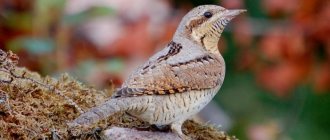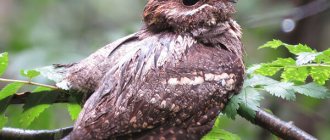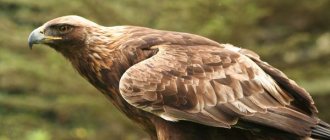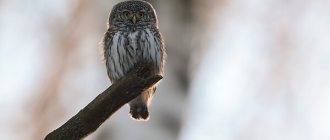- Wild animals
- >>
- Birds
Pelican (Pelecanus) is a waterfowl found in all parts of the world except Antarctica. Its figure and, above all, the very elastic skin on the lower beak make the bird unique and quickly recognizable. The eight pelican species have a patchy global distribution, ranging in latitude from the tropics to the temperate zone, although the birds are absent from inland South America, the polar regions and the open ocean.
Origin of the species and description
Photo: Pelican
The genus of pelicans (Pelecanus) was first officially described by Linnaeus in 1758. The name comes from the ancient Greek word pelekan (πελεκάν), which comes from the word pelekys (πέλεκυς), meaning “axe”. The family Pelicanea was introduced by the French polymath C. Rafinesque in 1815. Pelicans give their name to the pelican-like Pelecaniformes.
Video: Pelican
Until recently, the order was not completely defined and it included, in addition to pelicans, Gannets (Sulidae), Frigatebirds (Fregatidae), Phaetonidae (Phaethontidae), Cormorants (Phalacrocoracidae), Anhingidae, while the shoebill ( Shoebill), egret (Egrets) and ibises (Ibises) and spoonbills (Plataleinae) were among the stork birds (Ciconiiformes). It turned out that the similarity between these birds is accidental, the result of parallel evolution. Molecular-biological evidence from DNA comparisons clearly argues against such an association.
Interesting fact: DNA studies showed that three New World pelicans were descended from the American white pelican, and five Old World species were descended from the rose-backed pelican, while the Australian white pelican was their closest relative. The pink pelican also belonged to this lineage, but was the first to diverge from the common ancestor of the other four species. This discovery indicates that pelicans first evolved in the Old World and spread to North and South America, and the preference for nesting in trees or on the ground has more to do with size than genetics.
Fossils found indicate that pelicans have existed for at least 30 million years. The oldest known pelican fossils were found in early Oligocene deposits in the Luberon region of southeastern France. They are surprisingly similar to modern forms. A nearly complete beak has been preserved, morphologically identical to that of modern pelicans, showing that this advanced feeding apparatus already existed at that time.
In the early Miocene, the fossil genus Miopelecanus was named Miopelecanus, a species of M. gracilis initially considered unique based on certain characters, but then it was decided that it was an intermediate species.
Subspecies
The pink pelican lives over vast territories stretching from Eastern Europe to the very south of Africa and from the Balkans to the Philippines. However, no subspecies have emerged within this species. Local communities vary in color, size, and anatomical details.
In addition, individual variability is developed. But these variations are insignificant and do not provide grounds for classifying any population as an independent subspecies. Despite living in very different conditions, the pink pelican is a bird of a monotypic species.
Appearance and features
Photo: Pelican bird
Pelicans are very large waterfowl. The Dalmatian pelican can reach the largest sizes. This makes it one of the largest and heaviest flying birds. The smallest species is the brown pelican. The skeleton accounts for only about 7% of the body weight of the heaviest pelicans. The most striking feature of pelicans is their beak. The throat pouch is extremely enlarged and connected to the lower beak, from which it hangs like an elastic skin pouch. Its capacity can reach 13 liters and is used as a fishing net when catching fish. It closes tightly with a long, slightly downward-sloping upper beak.
The eight living species have the following characteristics:
- American white pelican (P. erythrorhynchos): length 1.3–1.8 m, wingspan 2.44–2.9 m, weight 5–9 kg. The plumage is almost entirely white, with the exception of the feathers on the wings, visible only in flight;
- American brown pelican (P. occidentalis): length up to 1.4 m, wingspan 2–2.3 m, weight 3.6–4.5 kg. This is the smallest pelican, distinguished by its brownish-brown plumage.;
- Peruvian pelican (P. thagus): length up to 1.52 m, wingspan 2.48 m, average weight 7 kg. Dark with a white stripe from the head to the sides of the neck;
- pink pelican (P. onocrotalus): length 1.40–1.75 m, wingspan 2.45–2.95 m, weight 10–11 kg. The plumage is whitish-pink, with pink spots on the face and legs;
- Australian pelican (P. conspicillatus): length 1.60–1.90 m, wingspan 2.5–3.4 m, weight 4–8.2 kg. Mainly white with patches of black, with a large, pale pink bill;
- pink-backed pelican (P. rufescens): length 1.25–1.32 m, wingspan 2.65–2.9 m, weight 3.9–7 kg. Gray-white plumage, sometimes pinkish on the back, with a yellow upper jaw and gray pouch;
- Dalmatian pelican (P. crispus): length 1.60–1.81 m, wingspan 2.70–3.20 m, weight 10–12 kg. The largest grayish-white pelican, has curly feathers on the head and upper neck;
- gray pelican (P. philippensis): length 1.27–1.52 m, wingspan 2.5 m, weight c. 5 kg. The plumage is mostly grey-white, with a gray crest. During the breeding season, pinkish with a spotted pouch.
general characteristics
Adults can grow up to two meters in length, while their body weight is about 15 kg. The appearance of all representatives of this variety has features characteristic of this family. The pelican's body itself is quite large and at the same time clumsy. Birds have large wings, thick and short legs, which have membranes between the toes. The tail is relatively small, rounded at the end. Pelicans have a long and physically developed neck.
The beak also differs in length and has a special hook at the end.
Unlike other birds, pelicans have a kind of skin pouch in the lower part of their beak, which sets them apart from other birds. With the help of such a bag, pelicans catch various aquatic inhabitants, most of which include fish.
The beak is considered one of the most prominent features of pelicans. Their throat sac is very voluminous and has a connection with the lower beak, from where it hangs. The capacity of such a skin bag is about 13 liters, which allows it to be fully used as a kind of net during aquatic hunting. The bag is closed with the help of a long upper beak inclined towards the bottom.
The plumage of pelicans is not very dense, which causes poor fit to the body. The bird's feathers get wet quite quickly, and therefore pelicans constantly have to squeeze them out using their beak to remove moisture.
The leading color in birds is white. Next to it there may be a grayish tint, often with a pink tone. At the same time, the flight feathers have a darker color.
Pelicans are also distinguished from other birds by their simple vocal abilities. During nesting, birds make loud sounds that resemble a muffled roar. At other times, birds also exchange vocal messages, but they do this infrequently. Pelicans for the most part prefer to remain silent.
The beak and other areas of the body that lack feathers have a bright color, which becomes prominent and attractive when searching for a partner during the mating season. In the occipital region of pelicans there is a certain crest, which is made up of feathers.
Females are not as brightly colored as males, in addition, they are characterized by smaller sizes.
Juveniles have dirty brown or gray plumage.
Elena
Ask a Question
Question to the expert
Why do pelicans have a hook on their beak?
The peculiar hook, which is located in the upper part of the beak, is a feature of the pelican, formed over a long evolutionary period. It is required not only to hold slippery food, but also to catch large fish that would otherwise slip out of the beak's grip.
Where does the pelican live?
Photo: Pelican in Russia
Modern pelicans live on all continents, excluding Antarctica. There are 2 species living in Russia: the pink pelican (P. onocrotalus) and the Dalmatian pelican (P. crispus). In Europe, there are numerous populations in the Balkans, with the most famous colonies of the pink and Dalmatian pelican located in the Danube Delta. In addition, these two species are still found on Lake Prespa and on the eastern coast of the Azov Sea. In addition, the Dalmatian pelican is also found in some colonies in the lower reaches of the Volga and on the northern coast of the Caspian Sea.
These two species and the gray pelican (P. philippensis) are also found in Western and Central Asia. The latter is also in South Asia. Africa is home to the rose-backed pelican (P. rufescens), which lives in tropical and subtropical regions. Breeding and wintering grounds are found in the Roselle Canyon, whose distribution extends from the Sahel to South Africa.
The Australian pelican (P. conspicillatus) lives in Australia and Tasmania, and is regularly found outside the breeding season in New Guinea, the Solomon Islands and the Lesser Sunda Islands. The American white pelican (P. erythrorhynchos) breeds in the North American Midwest and southern Canada and winters on the coasts of North and Central America. The coasts of the American double continent are home to the brown pelican (P. occidentalis).
Interesting fact: In winter, some species can withstand severe frosts, but require ice-free waters. Most species prefer fresh water bodies. They can be found in lakes or river deltas, and since pelicans do not dive deeply, they require shallow depths. This is the reason why birds are virtually absent from deep lakes. The brown pelican is the only species that lives exclusively near the sea all year round.
Most pelicans are not migratory birds moving short distances. This applies to tropical species, but also to Dalmatian pelicans of the Danube Delta. On the other hand, pink pelicans from the Danube Delta migrate to wintering areas in Africa after the breeding season. They spend two to three days in Israel, where tons of fresh fish are delivered to the birds.
Bird distribution
Pelican distribution map photo
Pelicans are common on all continents except Antarctica, in temperate and tropical climate zones. Seasonal migration depends on the specific places of residence of a particular population. To live, these birds choose shallow sea waters, shallow fresh and salt lakes, and the mouths of large rivers.
What does a pelican eat?
Photo: Pelican beak
The bird's food consists almost exclusively of fish. Pelicans are sometimes found feeding exclusively on crustaceans. In the Danube Delta, carp and perch are the most important prey for the local pelican species. The American white pelican feeds mainly on carp fish of various species, which are not of interest to commercial fisheries. In Africa, pelicans capture cichlid fish from the genera Tilapia and Haplochromis, and in southeastern Africa they capture eggs and chicks of Cape cormorants (P. capensis). The brown pelican feeds off the coast of Florida on menhaden, herring, anchovies and Pacific sardines.
Interesting fact: Pelicans eat 10% of their body weight in food per day. This is about 1.2 kg for a white pelican. If you add this up, the entire population of pelicans in Nakurusi, Africa, consumes 12,000 kg of fish per day or 4,380 tons of fish per year.
Different species use different hunting methods, but they all hunt primarily in groups. The most common method is to swim, driving the fish into shallow water where they can no longer escape deeper and thus be easily caught. Sometimes these actions are facilitated by strong blows of the wings on the surface of the water. Other options are to form a circle and block the fish's exit into the open space, or two straight lines swimming towards each other.
With their huge beaks, pelicans plow through the water and catch caught fish. The success rate is 20%. After a successful catch, the water remains outside the skin bag and the fish is swallowed whole. All species can also fish alone, and some prefer this, but the methods described above are observed in all species. Only brown and Peruvian pelicans hunt from the air. They capture fish at great depths, descending vertically from a height of 10 to 20 meters.
Now you know where the pelican bird puts the fish. Let's see how he lives in the wild.
Nutrition
Pelicans eat exclusively fish. The process of catching it is remarkable. Birds use collective food production, which is extremely rare among birds. They line up in a chain. They flap their wings, make a lot of noise and slowly move towards the shore. In this way, the fish are driven to shallow waters, where they are caught by pelicans.
There is no reliable evidence that this species can dive. The pink pelican in the photo or video only lowers its beak, head and neck into the water. The fishing process is similar to scooping fish with a ladle. Lucky anglers may be joined by cormorants or other waterfowl.
Features of character and lifestyle
Photo: Pelican in flight
Lives, reproduces, migrates, feeds in large colonies. Fishing takes up a very small part of the pelican's day, as most individuals finish feeding by 8-9 am. The rest of the day is spent lazing around—cleaning and bathing. These events are held on sandbanks or small islands.
The bird bathes, tilting its head and body towards the water, flapping its wings. The pelican opens its beak or spreads its wings when its temperature rises to thermoregulate its body. While defending their territory, males threaten intruders. The pelican attacks using its beak as its main weapon.
Interesting fact: The eight living species are divided into two groups, one containing four species of ground-nest builders with predominantly white plumage as adults (Australian, Dalmatian, Great White and American White Pelican), and the other containing four species with grey-brown plumage. which preferably nested in trees (pink, gray and brown pelicans) or on sea cliffs (Peruvian pelican).
The weight of the bird makes lifting a very difficult procedure. A pelican has to flap its wings on the surface of the water for a long time before it can rise into the air. But if the bird has successfully taken to the air, it continues its confident flight. Pelicans can fly for 24 hours without a break, covering up to 500 km.
The flight speed can reach 56 km/h, the altitude above sea level is more than 3000 m. In flight, pelicans bend their necks back so that the head is between the shoulders, and the heavy beak can be supported by the neck. Since the muscles do not allow constant flapping of their wings, pelicans alternate long phases of gliding with flapping.
Total information
Distribution and habitats
Currently, the Dalmatian pelican is more widespread than the pink pelican - nesting sites are located sporadically from the Balkan Peninsula to Mongolia and the upper reaches of the river.
Yellow River, in the south - to the Persian Gulf, in the north - to the Kurgan region. In the European part of Russia, it constantly nests in the Kuban delta, on Lake. Manych-Gudilo and Manych, deltas of the Volga and Terek. In the Asian part of Russia - in the Southern Trans-Urals on the lakes of the Tobol-Ishim interfluve. Arrives at nesting sites very early, on average in mid-March. In Transcaucasia along the Black Sea coast, migratory birds, depending on the spring, appear in late February - early March. They arrive in the Volga delta in mid-March. Autumn migration begins late, in October-November.
The Dalmatian pelican winters mainly in Iran, Iraq and Pakistan, northwestern India and southern China.
The main habitats of the pelican are river deltas, rich in aquatic vegetation and fish, fresh and brackish lakes with thickets, islands of salt lakes devoid of surface vegetation.
Social structure and reproduction
Photo: Pelican Family
Pelicans breed in colonies, with larger and denser colonies formed by birds that breed on the ground. Sometimes mixed colonies are created: in the Danube Delta, pink and Dalmatian pelicans often breed together. Tree-nesting species settle next to storks and cormorants. Pelican colonies used to number in the millions, the largest pelican colony today is the colony at Lake Rukwa in Tanzania with 40,000 pairs.
The breeding season begins in temperate latitudes in the spring, for European and North American species in April. In tropical climates there are usually no fixed breeding periods and the eggs may be incubated throughout the year. The beaks, pouches and bare facial skin of all species become brightly colored before the breeding season begins. Males perform a courtship ritual that differs from species to species, but involves raising the head and beak and inflating a ball of skin on the lower beak.
Nest construction varies greatly from species to species. Very often, one excavation is made in the soil without any material. Nests in trees are more complex structures. The gray pelican breeds on mango, fig or coconut trees. The nest consists of branches and is lined with grasses or decaying aquatic plants. It has a diameter of about 75 cm and a height of 30 cm. The stability of the nest is quite low, so a new nest is built every year.
Usually two eggs are laid, but clutches with one or even six eggs appear. Incubation time is 30 - 36 days. The chicks are initially naked, but quickly become covered with down. At the age of eight weeks, the downy dress gives way to young plumage. Initially, the cubs ate stale food porridge. The first chick to hatch pushes its brothers and sisters out of the nest. Between 70 and 85 days old, the chicks become independent and leave their parents after 20 days. At the age of three or four years, pelicans breed for the first time.
Mythological character
The unusual appearance of pelicans has long made them heroes of various works. They are mentioned in bestiaries. In ancient times, this was the name given to collections of zoological stories and poems. One of them tells how the mother jealously caressed the chicks with her beak and claws. As a result, they died. A few days later the father of the family appeared. He tore his chest into blood, washed the chicks with it and thereby revived them. This has caused the pelican to be compared to Jesus, who also sacrificed his life to save others.
So, in our article we looked at the description of the pelican. This bird lives in coastal areas with warm climates. In the temperate zone it is migratory. The pelican has a large body, short legs with well-developed membranes between the toes. These birds are excellent swimmers, dives and fly long distances. The calling card of pelicans is their wide, leathery beak. In it the bird keeps a large number of fish and other small aquatic inhabitants.
Natural enemies of pelicans
Photo: Pelican bird
Pelicans have long been hunted in many parts of the world for a variety of reasons. In East Asia, the fat layer of juvenile birds is considered a medicine in traditional Chinese medicine. Also in India, this fat is considered effective against rheumatic diseases. In southeastern Europe, the gular pouches of the beaks were used to make bags, tobacco pouches, and sheaths.
Interesting fact: The South American colonies of the brown pelican were exploited in a special way. Together with the Peruvian gannet and the bougainvillea cormorant, feces were collected on a large scale as fertilizer. As workers broke eggs and destroyed chicks, colonies were destroyed during exploitation work.
Sustainable coexistence between humans and gray pelicans occurs in villages in the Indian state of Karnataka. Where pelicans nest on the roofs of houses, like white storks. Local residents use the excrement as fertilizer and sell the excess to neighboring villages. Therefore, pelicans are not only tolerated, but also protected. In natural conditions, pelicans do not have many enemies among animals due to their impressive size.
The main predators of pelicans include:
- crocodiles (attack an adult bird);
- foxes (hunt chicks);
- hyenas;
- predator birds.
Interesting facts about the bird
Pelican feeding from its beak photo
- Dalmatian and gray pelicans are listed as vulnerable species on the International Union for Conservation of Nature Red List. The main reason for the decline in pelican populations is considered to be the widespread use of DDT and other strong pesticides in the middle of the last century. Birds received pesticides through their food and, as a result, their fertility decreased. Since 1972, the use of DDT in the United States and several other countries was banned and pelican populations began to recover. In captivity, pelicans live up to 20 years or more, but reproduce reluctantly.
- Pelicans are characters in many legends and fairy tales, which are based on myths about the bird’s self-sacrifice for the sake of its offspring. So, in the Middle Ages, this bird was a symbol of Jesus Christ. And in European heraldry, the pelican is a symbol of selfless parental love, since for a long time it was believed that the bird tears its chest with its beak and feeds the hungry chicks with its own blood. The pelican is the symbol of the Pedagogical University of Russia. A bird feeding its chicks is depicted on the gate at the entrance. The prize for the best teacher of the year in Russia is the Crystal Pelican figurine. And in Scandinavia, the pelican is the emblem of donors.
- The pelican is also an important alchemical symbol, as its beak is shaped like a retort.
- The Albanian 1 lek coin is decorated with the image of a pelican.
